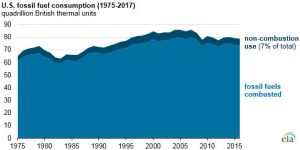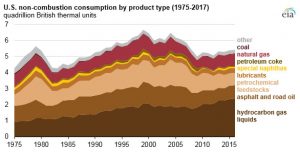7 percent of fossil fuels consumed for non-combustion purposes
The U.S. Energy Information Administration (EIA) estimates that, while the majority of fossil fuels in the U.S. are burned, or combusted, to produce heat and power, the equivalent of about 5.5 quadrillion British thermal units of fossil fuels were consumed for non-combustion purposes in the U.S. in 2017.

Fossil fuels that are not combusted accounted for 7 percent of the total fossil fuel use in 2017. Image courtesy of the Energy Information Administration. Click to enlarge.
According to the EIA, over the past decade, non-combustion consumption of fossil fuels has typically accounted for about 7 percent of total fossil fuel consumption and about 6 percent of total energy consumption in the U.S. Fossil fuels can be consumed, but not combusted, when they are used directly as construction materials, chemical feedstocks, lubricants, solvents, waxes and other products.
In 2017, about 13 percent of total petroleum products consumed were for non-combustion use, the EIA reports. Natural gas non-combustion use accounted for about 3 percent of total natural gas, while coal was less than 1 percent.
In 2017, carbon dioxide (CO2) emissions would have been 196 metric tons (about 4 percent) higher if non-combustion fuel use would have been combusted, the EIA says. The estimation of fossil fuels for non-combustion consumption is essential to calculate total U.S. CO2 emissions. According to the EIA, in the non-combustion of these fuels, some of the carbon is sequestered and not included in the fuel consumption values for emissions calculations.
Petroleum products account for about 86 percent of non-combustion consumption, the EIA reports. Hydrocarbon gas liquids are an important component for making plastics, while petrochemical feedstocks are used directly at chemical plants and to make synthetic fabric, synthetic rubbers, detergents and other chemical products.

Petroleum products account for 86 percent of all non-combustion consumption. Photo courtesy of The U.S. Energy Information Administration. Click to enlarge.
Petroleum products are also consumed for non-combustion purposes such as roofing and paving construction; vehicle and machinery lubricants; and as chemical catalysts. Other petroleum products include distillate and residual fuel oils used as chemical feedstocks as well as polishes and waxes, the EIA says.
Small amounts of natural gas are used in the industrial sector and as a feedstock to make nitrogenous fertilizers and a range of chemical products, including ammonia, hydrogen and methanol.
Small amounts of coal are used for non-combustion purposes. According to the EIA, among the byproducts of the process to produce metallurgical coke are coal tars, which are rich in aromatic hydrocarbons, such as benzene, and are used as feedstocks in the chemical industry to make sealcoats for pavement, synthetic dyes and paints. Additionally, some anti-dandruff shampoos and other medical skin care products contain coal tars.
Graphs: EIA
















